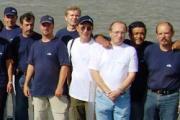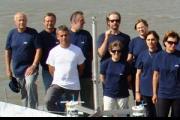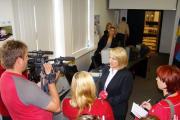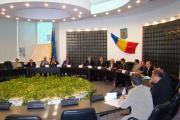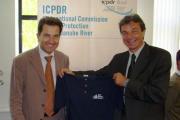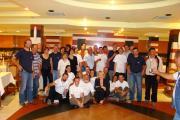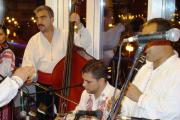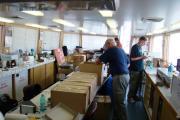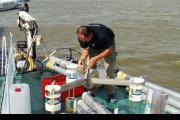
Chaired by Liviu Popescu, the Deputy Romanian National Team Coordinator, the event included speeches by: Minister Varga; ICPDR Executive Secretary Philip Weller; JDS2 Team Leader Béla Csányi; Marius Postelnicescu, General Director of the National Administration ‘Apele Romane'; Hogea Constantin, Mayor of Tulcea: Lester Chirica, Tulcea County Prefect; and Johannes Laber from Austria's Communal Credit Dexia Bank. The audience included journalists, the JDS2 Core Team and Romanian National Team, water managers from Apele Romana, NGOs and many others.
Later at 12:00, the official final press conference was held with opening speeches from Minister Varga, Weller and Csányi. In response to a journalist's question about water quality in Romania, an interesting discussion followed. It was noted, for example, that the worst microbiological results from the entire survey occurred on the Arges River, a Danube tributary which connects to the Romanian capital city of Bucharest upstream. In fact, survey numbers for the Arges were about four orders of magnitude higher than for any other sampling location. In response, Minister Varga noted that her ministry was committed to taking the required steps to resolve the problem, including future improvements to the treatment of wastewater from Bucharest.
Also during the discussion, Csányi noted that it was easier to make preliminary results from the biological studies made so far on the survey than from the chemical studies, given that he and his biology-focused colleagues were able to see with their own eyes, or on-board the ship, many of the organisms and habitats of the river system. Based on what they saw, he said that he was fairly convinced that many locations along the Danube remain in good condition. "And everything should be done to ensure they stay that way," he said.
After the press conference
Philip Weller presented ICPDR certificates of appreciation to each JDS2 Core Team member. The entire Core Team was then invited for an impressive boat tour inside the beautiful surroundings of the Danube Delta, provided by local hosts. "It was my first time there," says Slovak biologist Jarmila Makovinska. "We saw the main arm, smaller side arms, a lake and water snake. It was very nice, all the birds and flowers and trees."
Soon after their return to land, a celebratory party organized by the Romanian Ministry started up at around 19:00 with plenty of food and traditional folk music. Together, everyone celebrated the successful completion of the expedition - the biggest of its kind in the world, at least in 2007. National Team members even had the white T-shirts on their backs signed by Core Team members, in situ (as scientists say). And the celebration continued on the Szechenyi ship until...
After that, it was a very well-deserved rest, to get ready for packing the following day, as the last sampling site earlier scheduled for Friday had been completed on Wednesday. "When the second-last site at the Sulina arm was unexpectedly finished early, I asked my colleagues whether they thought it would be good to get the last one done that day," says Csányi. "They all agreed, and when we realized we had finished the entire survey programme, there was an indescribable enthusiastic feeling among the entire scientific team and crew."
"It's hard to believe we're finally in Tulcea, looking back at all the difficulties we had to go through," says JDS2 Technical Coordinator Jaroslav Slobodnik (who from start to finish, was the main human link between all of the tasks that needed to be done between ship and land, including making sure one particular web-writer regularly received reports and photographs from the ships, wherever they were, and whatever difficult conditions they were experiencing, at the time. "It's almost a miracle that we did it," he continues. "It was a success, and our only concern now is to write the final report."
"We are all tired, but we are happy," says Makovinska. "And a little bit sad. We all became a very close group. It's a good feeling for everybody."
On Saturday, the members go back to their homes and families throughout the Danube River Basin and beyond.
See the final press release that was distributed internationally here.












